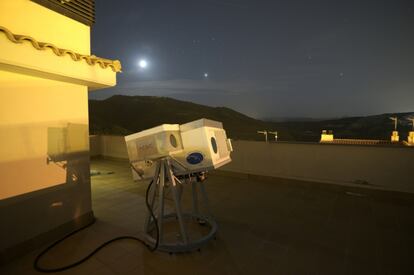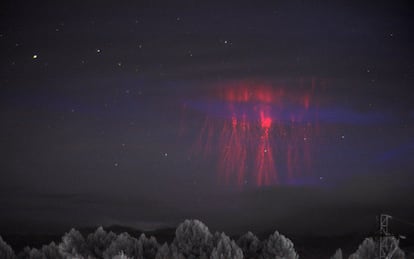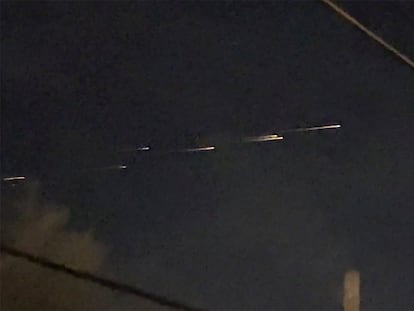The origin of mysterious green ‘ghosts’ in the sky has been discovered
Engineer María Passas Varo’s team reveals the causes of a strange electrical phenomenon, which draws spectral figures in storms

American Hank Schyma, a Texan rock singer also known as Pecos Hank, vividly remembers the day when his camera captured an unusual ghostly image in the sky. It was May 25, 2019, and he was recording a gigantic storm over Oklahoma. For just a few milliseconds, a strange greenish figure appeared high above the clouds, which he christened a ghost; that term is also the acronym for “Green emissions from excited Oxygen in Sprite Tops.” A team led by Spanish engineer Maria Passas Varo has now discovered the true origin of these ghosts in the sky: the presence of metals, especially iron and nickel, caused by interstellar dust entering the atmosphere.
The mysterious ghosts are only one type of transient luminous phenomenon. These optical events were first detected on the night of September 22, 1989, during a storm associated with a hurricane in the United States. Because they were fleeting and elusive, scientist Dave Sentman named them sprites, after Puck, the mischievous character in William Shakespeare’s comedy A Midsummer Night’s Dream. Since then, numerous transient luminous phenomena have been described, all of which have fanciful names. Elves are ring-like glows. Trolls are purple jets. Sprites are flashes of red, sometimes in the shape of jellyfish. And ghosts are green lights that, on rare occasions, emerge above the sprites.
María Passas Varo works at the Spanish Research Council’s Andalusia Institute of Astrophysics, in Granada, her hometown. She still excitedly remembers the day she learned that singer and storm chaser Hank Schyma had discovered a new transient luminous phenomenon. Passas Varo and her colleague Justo Sanchez del Rio had already designed an instrument to analyze the colorful, fleeting electrical discharges that appear above some storm clouds, at a height of between 40 and 90 kilometers (about 25 to 56 miles). In June 2019, the Spanish scientists decided to use their sophisticated tool to try to hunt for a green ghost in the skies over Spain.
The tool is located on the patio of Dutch meteorologist Oscar van der Veld, who works at the Polytechnic University of Catalonia and lives in the Barcelona town of Castellgalí. The challenge of finding a ghost was daunting. “Ghosts are super infrequent. One ghost comes from every 100 sprites,” says Passas Varo. Her observation instrument automatically points to the area of the sky where there are large storms through real-time consultation of the National Meteorological Agency database. Finally, on September 21, 2019, the team detected a jellyfish-shaped red sprite during a storm over the Mediterranean Sea. Above it, there was a fleeting green ghost.

British photographer Paul Smith describes himself as a “sprite chaser.” His colleague Hank Schyma immediately asked him if that ghostly green light over Oklahoma was normal. Smith thought it might be a camera error, but he patiently reviewed his own recordings and discovered several similar light phenomena. Together they decided to name it. Smith admits that they first spent several days trying to fit the acronym goblin; since they couldn’t come up with anything, Schyma ended up proposing ghost because he intuited that the phenomena were greenish emissions resulting from excited oxygen. “I had theorized that this green color must have some kind of oxygen involvement, as in nocturnal luminescence and auroras,” Smith recalls.
The results of Passas Varo’s analysis came as a surprise. “Our instrument has a spectrograph; it’s not a normal camera. It’s like the cover of Pink Floyd’s The Dark Side of the Moon album, which features a prism that white light hits and separates into a range of colors across the electromagnetic spectrum. We do the same. We separate the light that reaches us and see what chemical elements are involved in the process,” the telecommunications engineer explains. “The surprise was that there is oxygen, but very little of it. Most of it is iron,” she points out. This Tuesday, the results of Passas Varo’s study were published in the Nature Communications journal.

The new findings could explain why green ghosts are so infrequent in the skies. In four years of observations, Spanish scientists have only located one. “We didn’t expect there to be so much iron density at that altitude. It comes from meteors that enter the atmosphere at high speed, burn up and [then] the metal atoms are left suspended. The iron layer is normally a little bit higher. In our case, we hypothesized that on that day there were gravity waves [a wave phenomenon in the air] and the iron layer was lowered,” says Passas Varo.
The Spanish study is the first scientific publication on green ghosts. In 2019, Hank Schyma and Paul Smith turned to NASA physicist Burcu Kosar, an expert on transient luminous events. Just over a year ago, the U.S. space agency launched Spritacular, a program that encourages citizens to hunt for sprites, trolls, elves, ghosts and other creatures from the “electric zoo,” as Kosar puts it. Physicists aim to create a global database to solve outstanding riddles about the spectra in the skies: How often do they occur? Why do they take these forms? What atmospheric conditions trigger them?
These phenomena are difficult to observe with the naked eye, but they have sometimes been mistaken for UFOs, as a NASA report noted in September. María Passas Varo’s team posits a more pedestrian explanation: an electrical phenomenon associated with an anomalous amount of iron in the upper layers of the atmosphere. “They are lights in the sky that have a very strange shape that we are not used to seeing. It looks [like an] alien, but it is not,” jokes the researcher.
Sign up for our weekly newsletter to get more English-language news coverage from EL PAÍS USA Edition
Tu suscripción se está usando en otro dispositivo
¿Quieres añadir otro usuario a tu suscripción?
Si continúas leyendo en este dispositivo, no se podrá leer en el otro.
FlechaTu suscripción se está usando en otro dispositivo y solo puedes acceder a EL PAÍS desde un dispositivo a la vez.
Si quieres compartir tu cuenta, cambia tu suscripción a la modalidad Premium, así podrás añadir otro usuario. Cada uno accederá con su propia cuenta de email, lo que os permitirá personalizar vuestra experiencia en EL PAÍS.
En el caso de no saber quién está usando tu cuenta, te recomendamos cambiar tu contraseña aquí.
Si decides continuar compartiendo tu cuenta, este mensaje se mostrará en tu dispositivo y en el de la otra persona que está usando tu cuenta de forma indefinida, afectando a tu experiencia de lectura. Puedes consultar aquí los términos y condiciones de la suscripción digital.










































